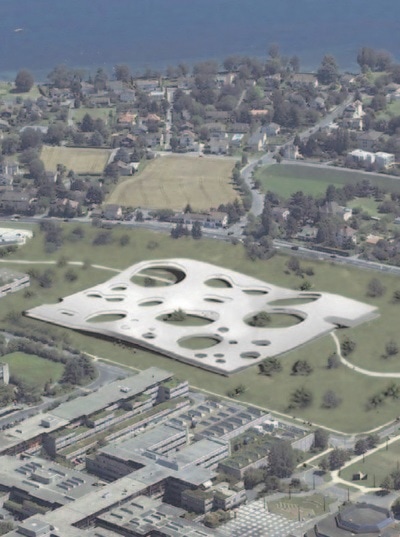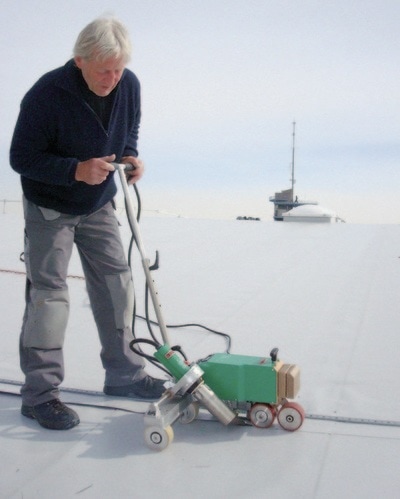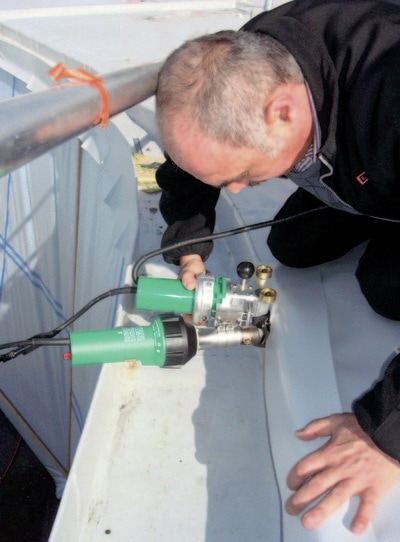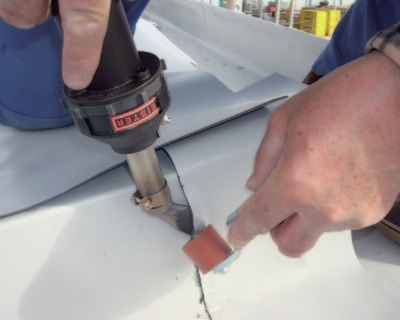|
The EPLF (Ecole Polytechnique Fédérale de Lausanne) is the confederate university of the French-speaking part of Switzerland. The “Rolex Learning Center” has been being built right next to the present-day campus over a three-year period. It will provide space for 700 students and teachers. In addition to a large library covering the history of science, exhibitions and conferences will take place. The complex also incorporates quiet areas and contact zones and catering facilities. The latest multimedia technology naturally has pride of place. Like Swiss cheese What, seen from the air, first reminds one of a Swiss cheese or a white wave, turns out to be, as you get closer, a very homogeneous structure. With its many green internal courtyards and its contoured roof structure it makes a very organic impression. No question: The EPLF, and thus, by association, the city of Lausanne has made this building into the architectural jewel in the crown. A decorative item which will cause a sensation far beyond the borders of Switzerland. The project was the subject of an international tendering process. Anyone of distinction took part. The tender of the well-known Japanese architects Kazuyo Sejima and Ryue Nishizawa at the renowned offices of SANAA in Tokyo was accepted. The duo got the better of established names such as Jean Nouvel, Herzog & de Meuron, Rem Koolhaas and Zaha Hadid. A project of this size can, these days, no longer be realised exclusively from the public purse. – Particularly as, in this case, the demands extended far beyond the simply functional. For this reason, famous Swiss companies have participated in this large-scale project. In addition to Rolex, the company providing the name, the list includes Credit Suisse, Novartis and Nestle. Unique challenge The enormous contoured flat roof presented a completely new challenge for the roofing contractors: There is virtually no straight roof termination. In addition, the curvature of the roof in the various sectors was something completely unique. The execution of the demanding roof sealing procedure was given to the company “Pilatus Flachdach AG” in Wollerau (Switzerland). Thermal insulation, consisting of 120 and 100 mm thick Flumroc (rockwool) was to be laid over the damp course. The actual roof skin was provided by Sarnafil. It consists of 1.8 mm thick reinforced PVC. In the edge area and in the guttering, slightly more flexible fibreglass-reinforced PVC G was used. The roof skin was fixed mechanically at the edge using rails. Not only the gigantic roof area, having external dimensions of 121 x 166 metres, made extraordinary demands on the roofers: Hundreds of metres of roof guttering needed to be neatly welded. About 3,000 lightning protection plates and dozens of skylights needed to be connected using the plastic sealing strips. Five staff from “Pilatus Flachdach AG” worked on the project for about six months. VARIMAT V and Sarnamatic 661 for the surface areas The expert roofers could count on the reliable automatic welding machines and hand-held units provided by Leister. The entire range of these high-performance units was deployed on this project. For the large areas, the VARIMAT V and the Sarnamatic 661 were used for overlap welding of the 1.8 mm thick strips. Both are automatic units which weld the plastic sealing strips without creasing at high speeds. This is a severe criterion on a surface area, in this case, of over 16,000 m2. Close to the edge, only one metre wide strips of plastic seal were laid to accommodate the wind loads. In the central area, from about 15 metres from the edge of the roof, two metre wide strips were laid. In the end, about 15 km of overlapping seams were welded. UNIROOF E for roof termination The new UNIROOF E was used in the rounded zones near to the edge. This automatic machine is very easy to handle and flexible as a result of its compact structure. Gradients of up to 30° can be accommodated thanks to its powerful motor. Even small radii can be processed with confidence. It knows virtually no barriers because of its small size. At an overall length of over 1,000 metres it was an aid without which cost-effective working would have been impossible. TRAIC DRIVE PID for increased productivity The smallest Leister automatic welding unit, the TRIAC DRIVE PID, was used in the guttering, at the roof terminations, at the lightning protection plates, at the covers of the rails for mechanical fixing and at the skylights. It also welds very tight radii. The use of this semi-automatic unit increases productivity tremendously compared to a hand-held welder. It proved its capabilities particularly when horizontally welding the many hundreds of metres of guttering. Without this unit, the work would have been an arduous and extended endeavour. TRIAC PID and HOT JET S for the details As a result of the extraordinary shape of the roof structure it was unavoidable that the experts from “Pilatus-Flachdach AG” – even using the powerful flexible automatic Leister welders – had to carry out a very large amount of “manual work”. The awkward details were handled using the two hand-held units, the TRIAC PID and the smaller HOT JET S. Both of them are units that have proved themselves hundreds of thousands of times all over the world. Here again they proved to be both reliable and easy to handle. Full product range in use Each of the Leister units used on this demanding roof stood the test admirably. Stefan Schwitter, responsible for the execution of this roof project, is full of praise for the quality and cost-effectiveness of the Leister equipment. The great advantage of having a single equipment supplier for the various different requirements is apparent to him: In the event of problems, he can rely on rapid assistance from the Leister Sales and Service partners in the vicinity. Worldwide effect The challenges provided by this demanding project required everything from the roofers. After the completion of this architectonic jewel they can be justifiably proud of their work. When the Rolex Learning Center is finished next year, “Pilatus Flachdach AG” can boast that they participated in a construction project which will probably be a show-stopper. And that the unconventional and challenging roof structure would not have achieved such quality without their support. – However, hardly without the help provided by the Leister equipment... Objekt: Rolex Learning Center der “EPLF”, Lausanne, Schweiz
Architects: Kazuyo Sejima + Ryue Nishizawa, Büro SANAA, Tokio, Japan Plastic sealing strips: Sarnafil Roofers: Pilatus Flachdach AG, Wollerau, Schweiz Welding equipment: Leister Process Technologies, Kaegiswil, Schweiz Leister Sales and Service partner: F. Jannone AG, Wabern, Schweiz Text: Christophe von Arx, Leister Process Technologies Photos: Roland Beeler, Leister Process Technologies Comments are closed.
|
|
STANMECH Technologies Inc.
944 Zelco Drive Burlington ON L7L 4Y3 | 1-888-438-6324 | [email protected] Terms of Use Privacy Terms and Conditions of Sale Warranty Policies |
|
Proud Member of:







